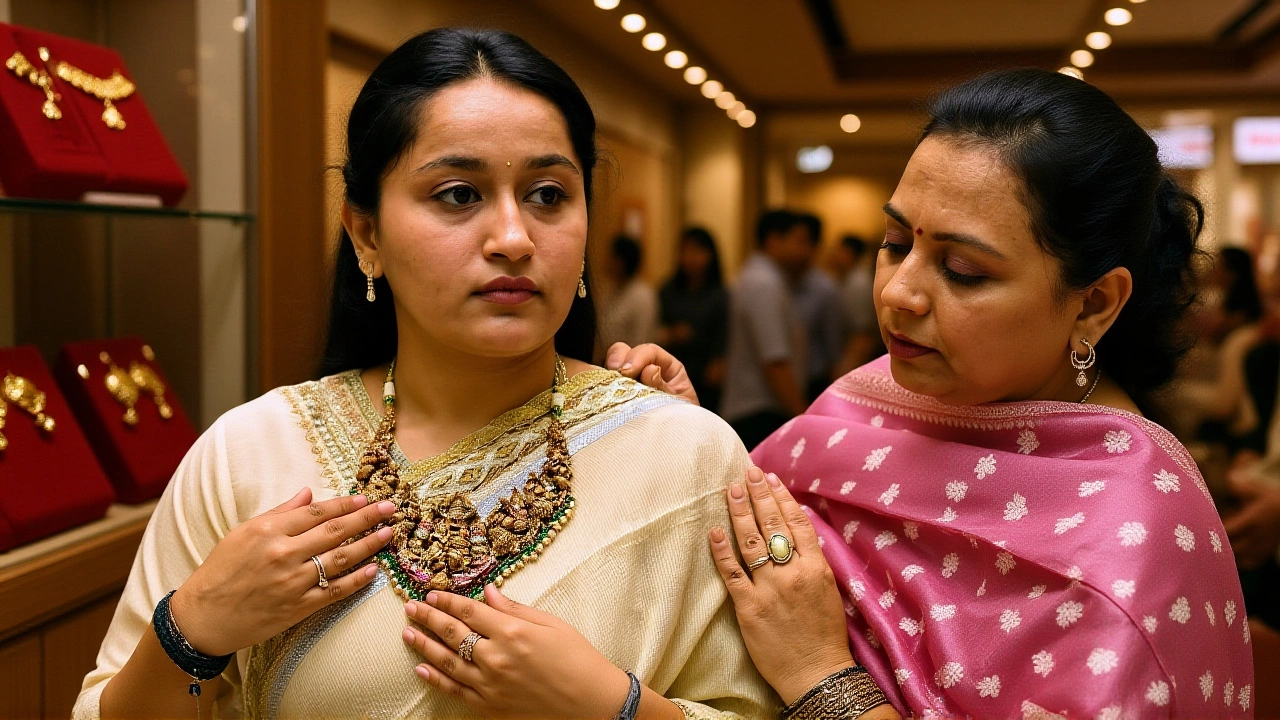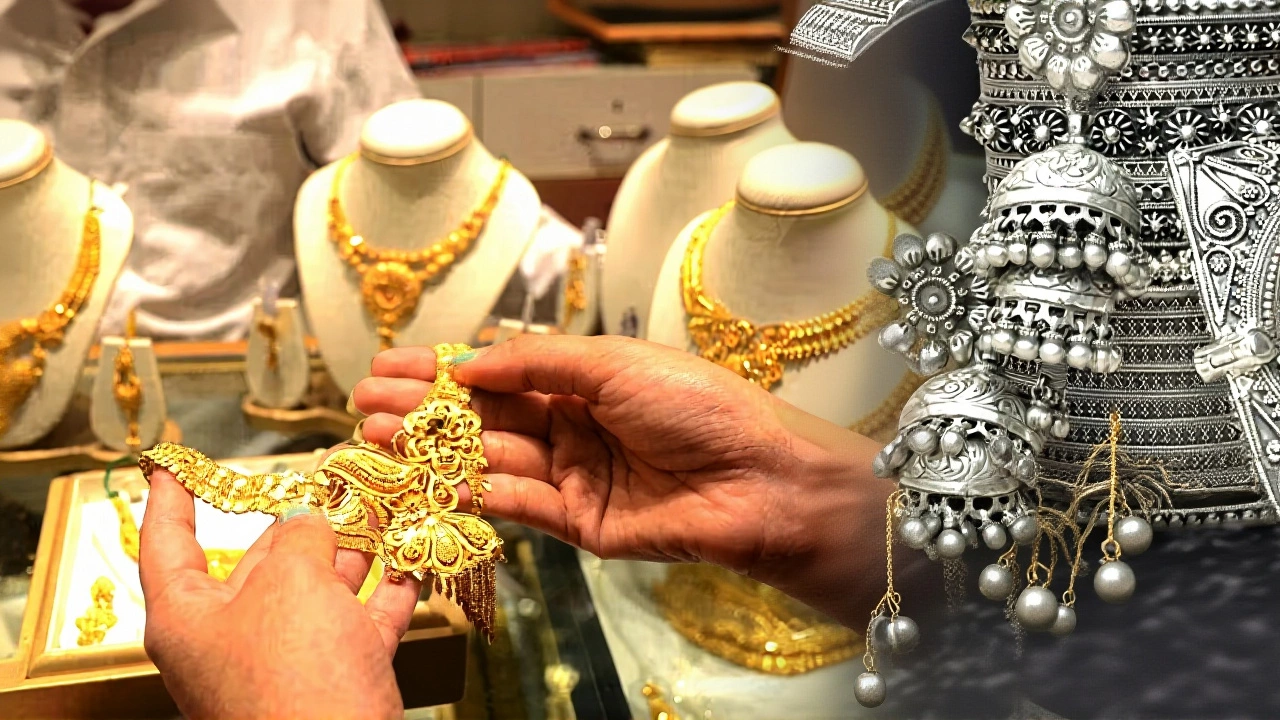Gold surged to record highs on Wednesday, October 15, 2025, as the December 5 contract on the Multi Commodity Exchange of India Ltd. (MCX) touched ₹1,27,500 per 10 grams before easing to ₹1,26,726, a 0.37 % intraday gain.
According to Kavita Chacko, market analyst for the World Gold Council, the rally reflects a perfect storm: renewed US‑China trade tensions, a weakening rupee and the approach of India’s festive buying season. The same day, India TV News reported that silver futures also rose, underscoring broader safe‑haven demand.
Why gold shot up: global and domestic forces
International prices broke the $4,000‑per‑ounce barrier on October 13, 2025, after a 58 % year‑to‑date climb — the steepest surge in 45 years. The jump from $3,500 to $4,000 happened in just 36 days, a pace unheard of since the early 2000s. Analysts point to three drivers: persistent geopolitical friction, especially the US‑China trade dispute that flared in early October, and a dollar that has been on a downtrend against major currencies.
Domestically, the Indian rupee slid about 3 % against the dollar in the week leading up to the price spike. That currency weakness amplifies every ounce of gold for Indian buyers, converting into a heftier rupee price even when global spot moves modestly.
What the numbers say: a deep‑dive into the market data
At 9:05 a.m. Eastern Time, Fortune.com logged the global spot price at $4,187 per ounce, up $78 from the previous session. On the MCX floor in Mumbai, the December 5 gold contract opened at ₹1,26,915 per 10 grams, a 0.52 % rise over the prior close of ₹1,26,256.
- December 5 contract peak: ₹1,27,500 per 10 g
- February 2026 contract at reporting time: ₹1,27,839 per 10 g (+0.27 %)
- Silver December 5 contract high: ₹1,61,418 per kg
- Gold ETFs in India saw record inflows in September 2025
- Gold imports hit a 10‑month high in August 2025
Silver, while still trailing gold in absolute terms, posted a 0.39 % rise to ₹1,60,131 per kilogram, reflecting its dual role as both industrial metal and safe‑haven asset.
How the Indian market is reacting
Listed jewellers across the country reported a 12 % jump in quarterly revenue, despite the price shock. The surge has also sparked a surge in consumer interest in gold‑linked investment products, with gold mutual funds and sovereign gold bonds seeing unprecedented subscription levels.
Retailers are cautiously optimistic about the upcoming Dhanteras (October 21, 2025). Historically, Dhanteras accounts for roughly 30 % of the year’s gold sales in India. Times Now News quoted trade bodies saying that the festival’s demand could offset the price‑squeeze, especially as recent GST cuts have boosted disposable income.

Analysts’ take: what could happen next?
Chacko warned that if the rupee continues to slide, the domestic premium could widen further, pressuring first‑time buyers. "We’re seeing a classic safe‑haven rally," she said, "but the underlying macro backdrop—weak growth forecasts in both the US and China—means investors may stay put until clear policy signals emerge."
On the other side, a few market strategists argue that the recent surge could be nearing its ceiling. They point to the fact that gold’s price‑to‑earnings multiple has stretched beyond historical norms, and any surprise on the Fed’s rate path could trigger a correction.
What the festive season means for buyers
For the average Indian shopper, the headline numbers can feel intimidating. Yet, experts say the festive season often brings promotional financing, lower making charges, and the chance to lock in a price before a potential dip. "If you’re buying for a wedding or Dhanteras, a modest down‑payment now could protect you from a higher price in January," suggested a senior manager at a leading jewellery chain.
Meanwhile, the World Gold Council’s October report highlighted that low inflation and a still‑healthy consumer sentiment index are likely to keep demand buoyant, even if prices hover near the current peak.

Key takeaways
- Gold hit an all‑time high of ₹1,27,500 per 10 grams on MCX.
- International spot crossed $4,000 per ounce, up 58 % YTD.
- US‑China trade tensions and a softening rupee are the primary catalysts.
- Festive demand, especially around Dhanteras, could sustain the rally.
- Analysts are split between expecting a plateau and a possible pull‑back.
Frequently Asked Questions
How will the rising gold price affect the average Indian consumer?
Higher prices mean larger upfront costs for jewellery and investment purchases. However, many retailers offer flexible EMI schemes during the festive season, and consumers can still lock in today's rates before any potential correction later in the year.
What role did US‑China trade tensions play in the price surge?
The renewed tariff threats and export‑control discussions revived safe‑haven buying. Investors turned to gold as a hedge against the uncertainty, pushing both global and Indian prices higher.
Is the current price level sustainable through the festive season?
Analysts say demand from Dhanteras and Diwali could keep prices elevated, but a sharp rupee recovery or unexpected policy easing could temper the rally.
What does the World Gold Council predict for gold’s year‑end outlook?
The Council expects gold to stay in the “high‑price” band, citing continued inflation worries and modest economic growth. They forecast a 5‑7 % increase from today’s levels by December.
Will silver follow gold’s upward trajectory?
Silver is already up 0.39 % today, but its industrial demand makes it more volatile. Experts expect it to rise in tandem with gold but with larger daily swings.
